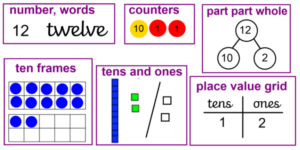As part of our place value learning in maths, we have been using a range of models to represent numbers up to 20.
We use real life examples to demonstrate how 10s and 1s can be used. Here are 12 pens made up of one pack of 10 and two ones.

By seeing and making a range of representations, children are able to secure a deep understanding of numbers.
Most of the following representations focus on partitioning (splitting up a number into parts) a number into tens and ones.
The middle box on the bottom row shows 12 being made by cubes. The second picture in that box is to show how the cubes can be drawn. Children find it far quicker and easier to draw a long line to represent a ten than drawing a rectangle that is divided into ten squares.

Try using these at home to support your child’s learning.